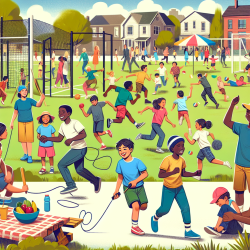Introduction
In the realm of childhood development and health, increasing physical activity among children is a critical goal. The study titled "Comparative Effectiveness of After-School Programs to Increase Physical Activity" provides valuable insights into how community-driven after-school programs (ASPs) can enhance physical activity levels in children. This blog post aims to explore the findings of this study and discuss how practitioners can leverage these insights to improve outcomes for children.
Study Overview
The research conducted by Gesell et al. (2013) compared two types of ASPs: a community recreation center-based program and a standard school-based program. The study involved 91 elementary school children, with 54 attending the community ASP and 37 attending the school-based ASP. Using accelerometry to measure physical activity, the study aimed to determine which program was more effective in increasing moderate to vigorous physical activity (MVPA) among children.
Key Findings
- Children in the community ASP showed a significant increase in MVPA by 14.7 percentage points over 12 weeks, compared to those in the school-based ASP.
- The community ASP was more cost-effective, requiring only an additional $1.59 per child per day to achieve these improvements.
- The structured, adult-led activities in the community ASP were pivotal in driving these positive outcomes.
Implications for Practitioners
Practitioners working in educational and recreational settings can draw several lessons from this study:
- Structured Activities: Implementing structured, adult-led activities can significantly boost physical activity levels among children.
- Community Engagement: Engaging community resources, such as local parks and recreation departments, can enhance program effectiveness and sustainability.
- Cost-Effectiveness: With minimal additional investment, community-driven programs can provide substantial health benefits, making them a viable option for schools and communities.
Encouraging Further Research
While this study provides a strong foundation, further research is needed to explore the long-term impacts of community-driven ASPs on children's health. Practitioners are encouraged to conduct additional studies to refine these programs and explore their potential in different settings and populations.
Conclusion
The findings from this study underscore the importance of community-driven, structured physical activity programs in after-school settings. By leveraging community resources and focusing on structured activities, practitioners can create impactful programs that enhance children's physical activity levels and overall health.
To read the original research paper, please follow this link: Comparative Effectiveness of After-School Programs to Increase Physical Activity.










